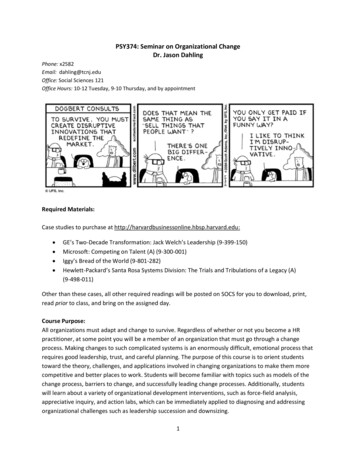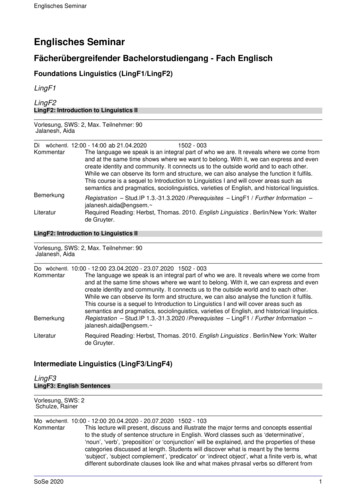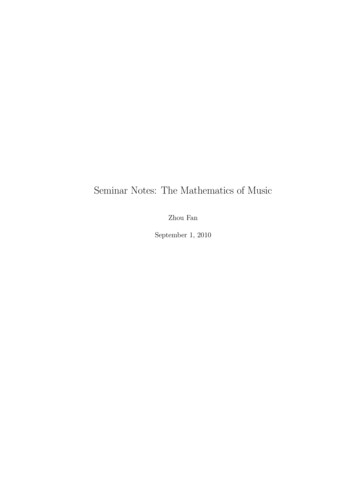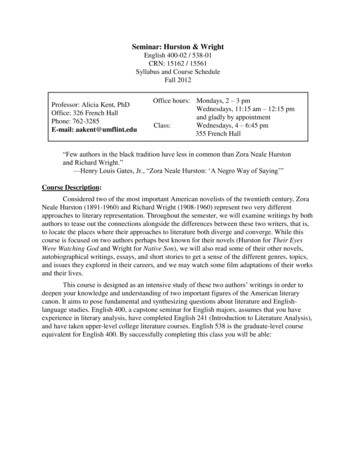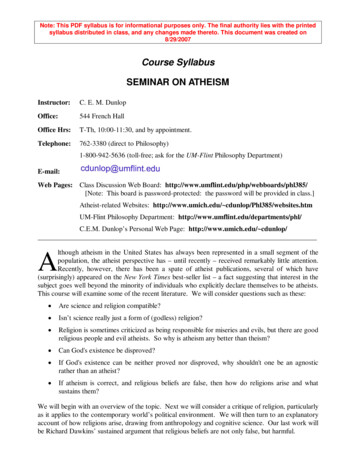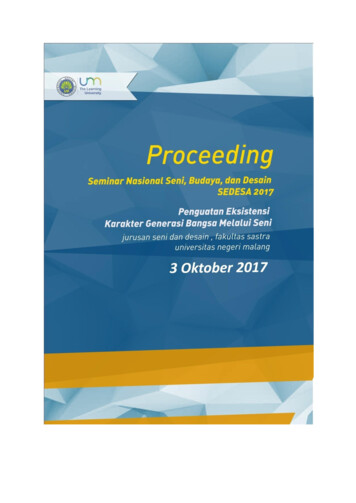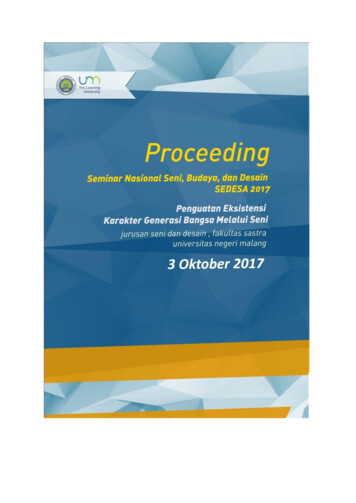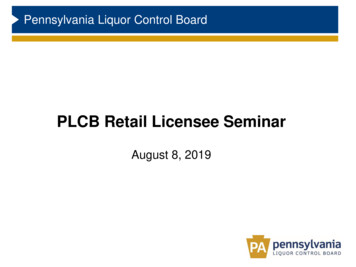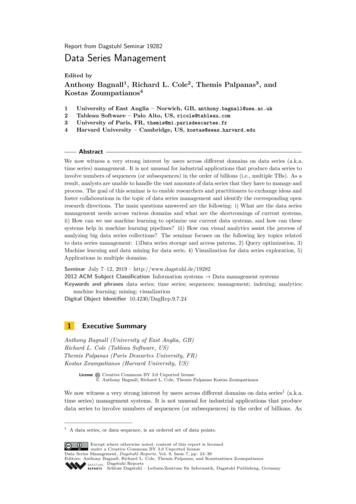
Transcription
Report from Dagstuhl Seminar 19282Data Series ManagementEdited byAnthony Bagnall1 , Richard L. Cole2 , Themis Palpanas3 , andKostas Zoumpatianos41234University of East Anglia – Norwich, GB, anthony.bagnall@uea.ac.ukTableau Software – Palo Alto, US, ricole@tableau.comUniversity of Paris, FR, themis@mi.parisdescartes.frHarvard University – Cambridge, US, kostas@seas.harvard.eduAbstractWe now witness a very strong interest by users across different domains on data series (a.k.a.time series) management. It is not unusual for industrial applications that produce data series toinvolve numbers of sequences (or subsequences) in the order of billions (i.e., multiple TBs). As aresult, analysts are unable to handle the vast amounts of data series that they have to manage andprocess. The goal of this seminar is to enable researchers and practitioners to exchange ideas andfoster collaborations in the topic of data series management and identify the corresponding openresearch directions. The main questions answered are the following: i) What are the data seriesmanagement needs across various domains and what are the shortcomings of current systems,ii) How can we use machine learning to optimize our current data systems, and how can thesesystems help in machine learning pipelines? iii) How can visual analytics assist the process ofanalyzing big data series collections? The seminar focuses on the following key topics relatedto data series management: 1)Data series storage and access paterns, 2) Query optimization, 3)Machine learning and data mining for data serie, 4) Visualization for data series exploration, 5)Applications in multiple domains.Seminar July 7–12, 2019 – http://www.dagstuhl.de/192822012 ACM Subject Classification Information systems Data management systemsKeywords and phrases data series; time series; sequences; management; indexing; analytics;machine learning; mining; visualizationDigital Object Identifier 10.4230/DagRep.9.7.241Executive SummaryAnthony Bagnall (University of East Anglia, GB)Richard L. Cole (Tableau Software, US)Themis Palpanas (Paris Descartes University, FR)Kostas Zoumpatianos (Harvard University, US)LicenseCreative Commons BY 3.0 Unported license Anthony Bagnall, Richard L. Cole, Themis Palpanas Kostas ZoumpatianosWe now witness a very strong interest by users across different domains on data series1 (a.k.a.time series) management systems. It is not unusual for industrial applications that producedata series to involve numbers of sequences (or subsequences) in the order of billions. As1A data series, or data sequence, is an ordered set of data points.Except where otherwise noted, content of this report is licensedunder a Creative Commons BY 3.0 Unported licenseData Series Management, Dagstuhl Reports, Vol. 9, Issue 7, pp. 24–39Editors: Anthony Bagnall, Richard L. Cole, Themis Palpanas, and Konstantinos ZoumpatianosDagstuhl ReportsSchloss Dagstuhl – Leibniz-Zentrum für Informatik, Dagstuhl Publishing, Germany
Anthony Bagnall, Richard L. Cole, Themis Palpanas, and Kostas Zoumpatianos25a result, analysts are unable to handle the vast amounts of data series that they have tofilter and process. Consider for instance that in the health industry, for several of theiranalysis tasks, neuroscientists are reducing each of their 3,000 point long sequences to justthe global average, because they cannot handle the size of the full sequences. Moreover,in the quest towards personalized medicine, scientists are expected to collect around 2-40ExaBytes of DNA sequence data by 2025. In engineering, there is an abundance of sequentialdata. Consider for example that each engine of a Boeing Jet generates 10 TeraBytes of dataevery 30 minutes, while domains such as energy (i.e., wind turbine monitoring, etc.), datacenter, and network monitoring continuously produce measurements, forcing organizationsto develop their custom solutions (i.e., Facebook Gorilla).The goal of this seminar was to enable researchers and practitioners to exchange ideasin the topic of data series management, towards the definition of the principles necessaryfor the design of a big sequence management system, and the corresponding open researchdirections.The seminar focused on the following key topics related to data series management:Applications in multiple domains: We examined applications and requirements originating from various fields, including astrophysics, neuroscience, engineering, and operationsmanagement. The goal was to allow scientists and practitioners to exchange ideas, fostercollaborations, and develop a common terminology.Data series storage and access patterns: We described some of the existing (academic andcommercial) systems for managing data series, examined their differences, and commentedon their evolution over time. We identified their shortcomings, debated on the best waysto lay out data series on disk and in memory in order to optimize data series queries, andexamined how to integrate domain specific summarizations/indexes and compression schemesin existing systems.Query optimization: One of the most important open problems in data series managementis that of query optimization. However, there has been no work on estimating the hardness/selectivity of data series similarity search queries. This is of paramount importancefor effective access path selection. During the seminar we discussed the current work in thetopic, and identified promising future research directions.Machine learning and data mining for data series: Recent developments in deep neuralnetwork architectures have also caused an intense interest in examining the interactionsbetween machine learning algorithms and data series management. We discussed machinelearning from two perspectives. First, how machine learning techniques can be applied fordata series analysis tasks, as well as for tuning data series management systems. Second,we how data series management systems can contribute towards the scalability of machinelearning pipelines.Visualization for data series exploration: There are several research problems in the intersection of visualization and data series management. Existing data series visualizationand human interaction techniques only consider very small datasets, yet, they can play asignificant role in the tasks of similarity search, analysis, and exploration of very large dataseries collections. We discussed open research problems along these directions, related toboth the frontend and the backend.19282
2619282 – Data Series Management2Table of ContentsExecutive SummaryAnthony Bagnall, Richard L. Cole, Themis Palpanas Kostas Zoumpatianos. . . .24Overview of TalksInteraction Metaphors for Time Series AnalysisAzza Abouzied . . . . . . . . . . . . . . . . . . . . . . . . . . . . . . . . . . . . . . . 28Mini Tutorial on Time Series Data Mining Top of FormAnthony Bagnall . . . . . . . . . . . . . . . . . . . . . . . . . . . . . . . . . . . . . 28Visualizing Large Time Series (a brief overview)Anastasia Bezerianos . . . . . . . . . . . . . . . . . . . . . . . . . . . . . . . . . . . 29Anomaly Detection in Large Data SeriesPaul Boniol . . . . . . . . . . . . . . . . . . . . . . . . . . . . . . . . . . . . . . . . 29Data Series Management and Query Processing in TableauRichard L. Cole . . . . . . . . . . . . . . . . . . . . . . . . . . . . . . . . . . . . . . 29Location IntelligenceMichele Dallachiesa . . . . . . . . . . . . . . . . . . . . . . . . . . . . . . . . . . . 30Data Series Similarity Search: Where Do We Stand Today? And Where Are WeHeaded?Karima Echihabi . . . . . . . . . . . . . . . . . . . . . . . . . . . . . . . . . . . . . 30Progressive PCA for Time-Series VisualizationJean-Daniel Fekete . . . . . . . . . . . . . . . . . . . . . . . . . . . . . . . . . . . . 30Deep Learning for Time Series Classification, and Applications in Surgical DataScienceGermain Forestier . . . . . . . . . . . . . . . . . . . . . . . . . . . . . . . . . . . .31Seismic Time Series: Introduction and ApplicationsPierre Gaillard . . . . . . . . . . . . . . . . . . . . . . . . . . . . . . . . . . . . . . 32Progressive Similarity Search in Large Data Series CollectionsAnna Gogolou . . . . . . . . . . . . . . . . . . . . . . . . . . . . . . . . . . . . . . . 32Model-Based Management of Correlated Dimensional Time SeriesSøren Kejser Jensen . . . . . . . . . . . . . . . . . . . . . . . . . . . . . . . . . . . 33Time Series RecoveryMourad Khayati . . . . . . . . . . . . . . . . . . . . . . . . . . . . . . . . . . . . . 33Adaptive and fractal time series analysis: methodology and applicationsAlessandro Longo . . . . . . . . . . . . . . . . . . . . . . . . . . . . . . . . . . . . . 33Helicopters Time Series Management & AnalysisAmmar Mechouche . . . . . . . . . . . . . . . . . . . . . . . . . . . . . . . . . . . .34Socio-temporal Data MiningAbdullah Mueen . . . . . . . . . . . . . . . . . . . . . . . . . . . . . . . . . . . . . .34Data Series Mining and ApplicationsRodica Neamtu . . . . . . . . . . . . . . . . . . . . . . . . . . . . . . . . . . . . . .34
Anthony Bagnall, Richard L. Cole, Themis Palpanas, and Kostas Zoumpatianos27Fulfilling the Need for Big Sequence AnalyticsThemis Palpanas . . . . . . . . . . . . . . . . . . . . . . . . . . . . . . . . . . . . . 35Accelerating IoT Data Analytics through Time-Series Representation LearningJohn Paparrizos . . . . . . . . . . . . . . . . . . . . . . . . . . . . . . . . . . . . . . 36Contradictory Goals of Classification, Accuracy, Scalability and EarlinessPatrick Schäfer . . . . . . . . . . . . . . . . . . . . . . . . . . . . . . . . . . . . . . 36More Reliable Machine Learning through RefusalsDennis Shasha . . . . . . . . . . . . . . . . . . . . . . . . . . . . . . . . . . . . . .37Systems and Tools for Time Series AnalyticsNesime Tatbul . . . . . . . . . . . . . . . . . . . . . . . . . . . . . . . . . . . . . . .37Data Series Similarity SearchPeng Wang . . . . . . . . . . . . . . . . . . . . . . . . . . . . . . . . . . . . . . . .37Tableau for Data SeriesRichard Wesley . . . . . . . . . . . . . . . . . . . . . . . . . . . . . . . . . . . . . . 38Managing and Mining Large Data Series CollectionsKonstantinos Zoumpatianos . . . . . . . . . . . . . . . . . . . . . . . . . . . . . . . 38Participants . . . . . . . . . . . . . . . . . . . . . . . . . . . . . . . . . . . . . . . . . 3919282
2819282 – Data Series Management33.1Overview of TalksInteraction Metaphors for Time Series AnalysisAzza Abouzied (New York University – Abu Dhabi, AE)LicenseCreative Commons BY 3.0 Unported license Azza AbouziedThrough Qetch, I describe how a simple canvas metaphor can afford an intuitive and powerfulquerying language by allowing users to sketch patterns of interest, annotate them, as wellas apply regular expression operations to search for repeated patterns or anomalies. Thecanvas metaphor also affords powerful multi-series querying functionality through the relativepositioning of sketches. Through revisiting fundamental interaction metaphors, we canuncover elegant mechanisms for other complex time series analysis tasks.3.2Mini Tutorial on Time Series Data Mining Top of FormAnthony Bagnall (University of East Anglia – Norwich, GB)LicenseCreative Commons BY 3.0 Unported license Anthony BagnallTSDM is a research are that involves developing algorithms for tasks relating to time series.These can be grouped into two families of tasks:1. Specializations of generic machine learning tasks: classification, regression, clustering, rulediscovery and query problems, and all variants thereof, such as semi-supervised/activelearning, attribute selection, reinforcement learning, etc.2. Time series specific tasks:a. Forecasting/panel forecasting;b. Time to event modelling/survival analysis;c. Annotation, such as segmentation, anomaly detection, motif discovery, discretization,imputation.Problems can move from one task to another through a reduction strategy. For example,a regression task can be transformed to a classification task through discretizing the responsevariable, and forecasting can be reduced to regression through applying a sliding window.The challenges for TSDM include promoting reproducibility through open source code andimproving evaluation strategies through better use of public data repositories and dealingwith the challenges of large data so that algorithms can balance scalability vs accuracy.This becomes hugely important when dealing with streaming data, in particular with IoTapplications involving widespread sensor nets where decisions need to be made about whatdata to store.
Anthony Bagnall, Richard L. Cole, Themis Palpanas, and Kostas Zoumpatianos3.329Visualizing Large Time Series (a brief overview)Anastasia Bezerianos (INRIA Saclay – Orsay, FR)LicenseCreative Commons BY 3.0 Unported license Anastasia BezerianosVisually representing in a meaningful way large timeseries remains a research challengefor the visualization community. We present examples of existing approaches that attackthe problem using different solutions, such as representing visual aggregations, illustratingrepresentative patterns in the data, or creating novel compact visual representations. Onekey aspect in deciding what to visualize and how, is to understand why the timeseries needsto be visualized – i.e., what tasks the viewer needs to perform. This influences both whattype of visual representation is more appropriate to use, but also what interactions need to besupported to help visual analysis. We conclude with general challenges (and new directions)in visualizing and iteratively interacting with large amounts of data in real time.3.4Anomaly Detection in Large Data SeriesPaul Boniol (Paris Descartes University, FR)Creative Commons BY 3.0 Unported license Paul BoniolMain reference Paul Boniol, Michele Linardi, Federico Roncallo, Themis Palpanas: “Automated AnomalyDetection in Large Sequences”, ICDE, 2020.LicenseSubsequence anomaly (or outlier) detection in
Report from Dagstuhl Seminar 19282 Data Series Management Editedby Anthony Bagnall1, Richard L. Cole2, Themis Palpanas3, and Kostas Zoumpatianos4 ll@uea.ac.uk
